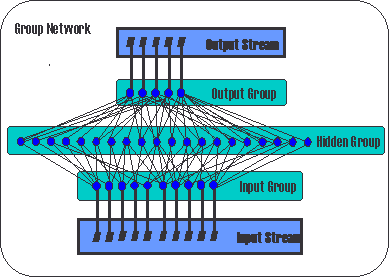INTRODUCTION
All tools in the NICO toolkit are commands
that can by entered at the shell prompt or run from a shell script. If
a command is run without any arguments, the syntax of that command is printed
together with a brief description of the command's options and their default
values.
The tools of the NICO toolbox can be divided
into the following broad classes:
Building tools --
Defining the network topology, specifying I/O formats etc.
Training tools --
Normalizing the input data, back-prop training, pruning etc.
Evaluation tools --
Running the network, Classification evaluation etc.
Building tools
It is good practice to
make shell scripts with building tools that defines the network topology.
For example, Figure 1 shows a network and a shell script that was used
to construct it.
 |
#!/bin/sh
NET=my_net.rtdnn
INPDIM=10
HIDDENSIZE=20
OUTDIM=5
CreateNet $NET $NET
AddGroup input $NET
AddUnit -i -u $INPDIM input $NET
AddGroup hidden $NET
AddUnit -u $HIDDENSIZE hidden $NET
AddGroup output $NET
AddUnit -o -u $OUTDIM output $NET
Connect input hidden $NET
Connect hidden output $NET
AddStream $INPDIM r INPUT $NET
LinkGroup INPUT input $NET
AddStream $OUTDIM t OUTPUT $NET
LinkGroup OUTPUT output $NET
|
Figure 1. A simple three-layer network
and a script file that created it.
Let's look at the commands in the shell
script from the top to the bottom. The first NICO command is CreateNet.
It simply creates a network definition file for a new network. The second
argument is the file name.
The second NICO command is AddGroup.
It adds a new group to the created network. A group is an object that can
have units or other groups as members. The next command is AddUnit.
It creates unit(s) and puts them in a specified group. After this first
AddUnit command, the network consists of a group named "input" containing
10 units (the -i option to AddUnit specified that it is input units and
the -u option specified that 10 units should be created).
The next two commands, AddGroup and AddUnit,
creates another group holding 20 hidden units and then the last group,
the output group is created with 5 output units (the -o option specifies
that is output units).
Now, adding connections from units in the
input group to the hidden units and from the hidden units to the output
units is a simple matter. The two Connect commands does just that.
Finally we need to connect our network
to the outside world. In the NICO toolkit this is taken care of by stream
objects. Here we add one input stream and one output stream with the two
AddStream
commands. The LinkGroup commands tells the network which units should
be associated with which stream.
For the network to be useful, some more
information must be specified. The data format, directory and file extension
for each stream should be specified (see AddStream and EditStream).
The command Display is useful for
examining a network definition file. If no options are given (Display my_net.rtdnn),
a brief description is printed. But Display has many options to explore
all properties the networks.
Here is a list of some useful building
tools:
Create objects: CreateNet, AddGroup, AddUnit,
AddStream
Link units to streams: LinkGroup, LinkUnit
Create connections: Connect, Pipe
Manage groups: Copy, Move, Import, Rename,
Join, UnJoin
Set properties: SetType, SetPlast, Protect
Display network properties: Display
Training tools
The NICO toolkit has only one main training
tool: BackProp. It runs backpropagation through time. However, we
have put a few other commands in this group. The most important is NormStream.
Most external data is not in the range suitable for ANN computation. Therefore
the best results are achieved when the external data is normalized to the
range [-1; 1]. From my experience, the -d option (standard deviation based
normalization) gives the best results.
Here is a list of training tools in the
NICO toolkit:
BackProp, NormStream, Prune, KickNet, NormGroup
Evaluation Tools
Several tools for evaluating and running a
trained network are available. The main tool for running a network is Excite.
It reads input streams, excites the network and outputs the output streams
or a selection of unit activities.
CResult is a tool for evaluating
classification performance. It has many analysis options such as confusion
matrix and "within top-N".
These are the evaluation tools:
Excite, CResult
